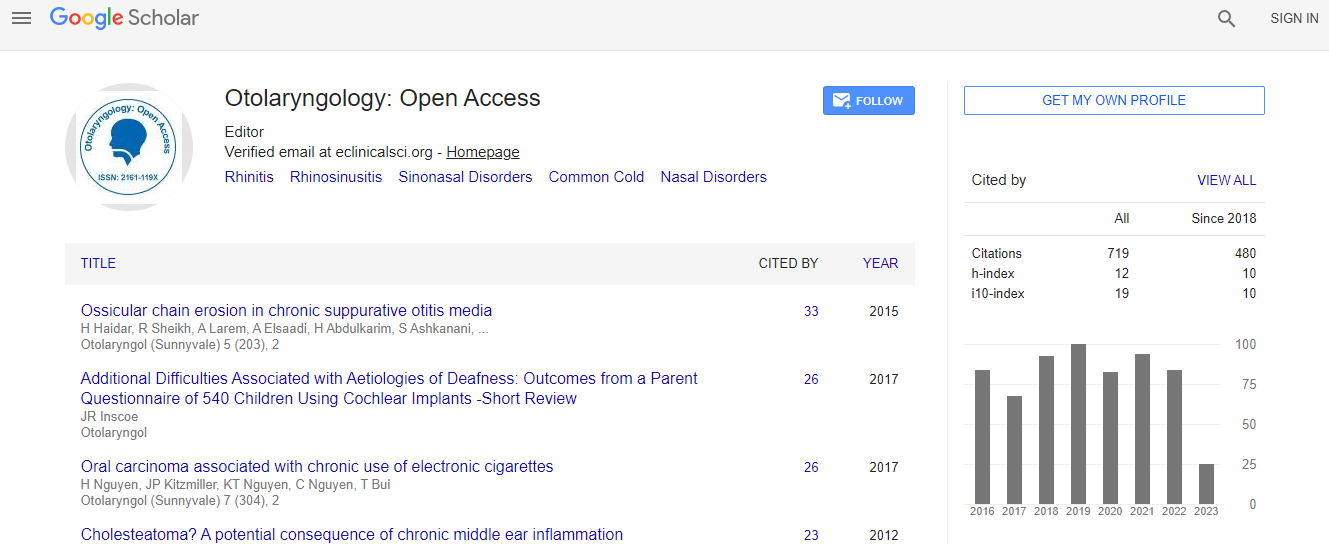Our Group organises 3000+ Global Conferenceseries Events every year across USA, Europe & Asia with support from 1000 more scientific Societies and Publishes 700+ Open Access Journals which contains over 50000 eminent personalities, reputed scientists as editorial board members.
Open Access Journals gaining more Readers and Citations
700 Journals and 15,000,000 Readers Each Journal is getting 25,000+ Readers
Google Scholar citation report
Citations : 925
Otolaryngology: Open Access received 925 citations as per Google Scholar report
Otolaryngology: Open Access peer review process verified at publons
Indexed In
- Index Copernicus
- Google Scholar
- Sherpa Romeo
- Open J Gate
- Genamics JournalSeek
- RefSeek
- Hamdard University
- EBSCO A-Z
- OCLC- WorldCat
- Publons
- Geneva Foundation for Medical Education and Research
- ICMJE
Useful Links
Recommended Journals
Related Subjects
Share This Page
Static and dynamic application of Multi-Planar Reconstructed (MPR) and 3D CT images to improve image guidance for FESS, based on lamellae landmarks
5th Global Summit and Expo on Head, Neck and Plastic Surgery
Simion J. Zinreich
Johns Hopkins University School of Medicine, USA
Keynote: Otolaryngol (Sunnyvale)
Abstract
For 3 decades, coronal sinus CT along with MPR reconstructions/displays has guided surgeons performing Functional Endoscopic Sinus Surgery (FESS) in their procedures. Image Guided Surgery (IGS) has improved the familiarity of the surgeon with the surgical field and correlation between the regional morphology and the imaging information. Unfortunately, image guidance is not always or universally available. For these situations, it is our work to provide the FESS surgeons more dynamic use of the imaging information to guide their surgical approach in a systematic and safe manner, using landmarks they are already familiar with. Teaching Points: The surgical approach for FESS is systematic, as it progressively follows sequential surgical steps and landmarks, based on the four lamellae from anterior to posterior, uncinate process, ethmoidal bulla, basal lamella and superior turbinate. The aim of this communication is to highlight the CT evaluation of the structures related to each of these 4 lamellae and the important role that dynamic multiplanar reformatting can play. Imaging evaluation will specifically focus on the structures involved in the performance of the 4 steps of the surgery, namely uncinectomy, anterior and posterior ethmoidectomy, sphenoidotomy and frontal sinusotomy. Summary: Aim of this presentation is to show that, using orthogonally reconstructed MPR CT images can provide a more accurate display of the structures of the nasal cavity and the paranasal sinuses in preparation for FESS. Use of a more dynamic CT display is needed and more advantageous to demonstrate the intricate relationship and structural variations surrounding the various mucociliary outflow tracts/drainage pathways. Curved coronal and 3D reconstructions are needed to display the usually convoluted path of the frontal recess and its outflow tract. In general, this dynamic approach of the imaging evaluation can provide a more accurate pre-surgical planning platform, especially in instances where image guidance is unavailable for surgery.Biography
Simion J. Zinreich is the professor of the Division Radiology and Otorhinolaryngology Head and Neck Surgery at The Johns Hopkins Medical Institution. He is an author/co-author of 7 patents, 150 publications and 5 textbooks. He is also an active member of Member of several national and international societies.
Email: sjzinreich@yahoo.com

 Spanish
Spanish  Chinese
Chinese  Russian
Russian  German
German  French
French  Japanese
Japanese  Portuguese
Portuguese  Hindi
Hindi 
